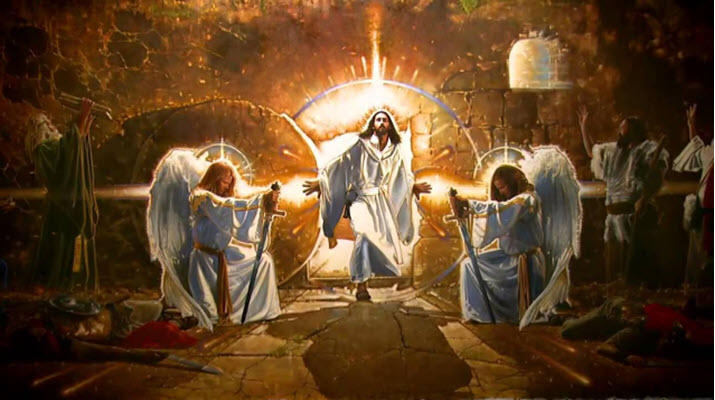الدليل الاقدم لموت وقيامة المسيح

السجل المبكر لموت وقيامة المسيح في كرونثوس الاولي 15 :3-7 والتقليد الشفوي والمقارنة بالمصدر المتأخر في القرآن.
تم تقييم المصادر المتاحة لقيامة المسيح من قبل المؤرخين. لكن السؤال الهام ماهو تاريخ تلك المصادر. بالنسبة بما يتعلق بالشهادات المبكرة من المسيحية. قال المؤرخ “ديفيد فيشر “David Hacket Fisher:”المؤرخ لا يجب ان تتوافر لديه ادلة قوية فحسب. لكن ان تتوافر لديه افضل الادلة القوية وثيقة الصلة. وافضل الادلة القوية ذات الصلة. هي مع الاخذ بعين الاعتبار ,ان هذه الادلة تكون اقرب مباشرتاً من الحدث نفسة. ” (1)
المفتاح الرئيسي في دراسة المصادر المبكرة في حياة المسيح هو ان تضع في الحسبان الثقافة والبيئة اليهودية التي ولَّد بها يسوع. كما يلاحظ “بول بارنيت Paul Barnett“ان وسط المسيحية المبكرة التي كانت مكتوب بها رسائل بولس والاناجيل كان مناخ رباني rabbinic ” (2)(متعلق بالمعلمين من حيث التعاليم واللغة ووجهات النظر). ونظراً للتشديد علي التعليم في المجمع. والمنزل. والتعليم الأولي. فانه ليس من المستغرب انه كان من الممكن للشعب اليهودي اعادة سرد(بالاسلوب الشفوي) وحكي كميات كبيرة من المواد التي كانت ايضاً اكبر بكثير من الاناجيل نفسها.
يذكر العهد الجديد المسيح بكونه رابي “Rabbi” في المواضع الاتية:(- متي 8 : 19 , 9 : 11 , 12: 28 , مرقس 4: 28 , 5: 35 , 9: 17 , 10 :17-20 ,12 :14 ,19, 32 ولوقا 19: 39 , ويوحنا 1 :38 , 3 :2 ) والكلمة تعني معلم او سيد. “وهناك العديد من العبارات التي من خلالها نستطيع ان نشاهد ونعرف معني جزء من مصطلح rabbinic في هذه الايام. حينما ذكر العهد الجديد تلك العبارات :وكان التلاميذ ” “تأتي ” اليه “تتبعه” “تتعلم منه” “وحمل النيره”(متي 11 :28- 30 مرقس 1 ).
(3) وبالتالي يبدو ان الانجيل في بداية انتشاره كان في شكل او قالب تراتيل وعقائد شفوية. بامكانك الرجوع لتلك المواضع:(لوقا 24 :34 ,اعمال الرسل 2 :22-24 ,30 -32 ; 3: 13-15 و 4 :10-12 و5 :29-32 ,10 :39 -41 ,13: 37- 39 , رومية 1: 3-4 ,4 :25 ,10 :9 , كورنثوس الاولي 11 :23 ,15: 3-8 وفليبي 26-11,وتيميثاوس الاولي 2 : 6 ,3: 16 ,6: 13 ,تيميثاوس الثانية 2 :8 وبطرس الاولي 3 :18 ويوحنا الاولي 4: 2 ) فكان هناك عناية هائلة وعظيمة “بالتسليم delivering”أي التقاليد المستلمة. فنجد ان يسوع استخدم التوازي parallelism و الايقاع والقافيةوالجناس والسجع. حيث مَكنة كلمات يسوع ليس فقط الحفظ من خلال الذاكرة بل السهولة في المحافظة علي تلك الكلمات.
(4) حتي بولس الرسول ,استخدمها. حيث دُرب علي يد رابي مختص في مدرسة رابانية تدعي هليل وهو الرابي” غمالئيل ” وهو رئيس وعضو في السنهدريم. يمكن ملاحظة ان كُتاب العهد الجديد وظفوا مصطلحات التقاليد الشفوية مثل: “تسليم” “تلقي” “يمر علي” “التعلم” “التمسك ” فالتعليم التقليدي يظهر في العهد الجديد بالقاء نظرة علي الفقرات الاتية:-
رومية ١٦ : ١٧ ١٧وَأَطْلُبُ إِلَيْكُمْ أَيُّهَا الإِخْوَةُ أَنْ تُلاَحِظُوا الَّذِينَ يَصْنَعُونَ الشِّقَاقَاتِ وَالْعَثَرَاتِ، خِلاَفًا لِلتَّعْلِيمِ الَّذِي تَعَلَّمْتُمُوهُ، وَأَعْرِضُوا عَنْهُمْ. كورنثوس الاولى ١١ : ٢٣ ٢٣لأَنَّنِي تَسَلَّمْتُ مِنَ الرَّبِّ مَا سَلَّمْتُكُمْ أَيْضًا: إِنَّ الرَّبَّ يَسُوعَ فِي اللَّيْلَةِ الَّتِي أُسْلِمَ فِيهَا، أَخَذَ خُبْزًا فيلبى ٤ : ٩ ٩وَمَا تَعَلَّمْتُمُوهُ، وَتَسَلَّمْتُمُوهُ، وَسَمِعْتُمُوهُ، وَرَأَيْتُمُوهُ فِيَّ، فَهذَا افْعَلُوا، وَإِلهُ السَّلاَمِ يَكُونُ مَعَكُمْ. تسالونيكى الثانية ٢ : ١٥ ١٥فَاثْبُتُوا إِذًا أَيُّهَا الإِخْوَةُ وَتَمَسَّكُوا بِالتَّعَالِيمِ الَّتِي تَعَلَّمْتُمُوهَا، سَوَاءٌ كَانَ بِالْكَلاَمِ أَمْ بِرِسَالَتِنَا. رسالة 1 كورنثوس 15: 3-7 والموثوقية المبكرة لعقيدة صلب وموت المسيح:
يطبق بولس الرسول التقليد الشفوي في رسالة 1 كورنثوس 15: 3-7 التي تعد واحده من أقدم السجلات التاريخية لمضمون الأنجيل لعقيدة –موت وقيامة المسيح. العالم اليهودي الارثوزكسي الراحل” بنحاس لبيد Pinchas Lapide” كان معجباً جداً بالعقيدة التي في كورنثوس الاولي 15 و خلص الي ان “يمكن اعتبارها كصيغة ايمان كبيان من شهود العيان” (5) أستخدَام بولس لمصطلحات ربانية مثل “استلمت received ” “ما قبلته” يمكن مشاهدتها في رسالة كورنثوس الاولي 15 :3-8. . في الفقرات الاتية:-
3 فإنني سلمت إليكم في الأول ما قبلته أنا أيضا: أن المسيح مات من أجل خطايانا حسب الكتب 4 وأنه دفن، وأنه قام في اليوم الثالث حسب الكتب 5 وأنه ظهر لصفا ثم للاثني عشر 6 وبعد ذلك ظهر دفعة واحدة لأكثر من خمسمئة أخ، أكثرهم باق إلى الآن. ولكن بعضهم قد رقدوا 7 وبعد ذلك ظهر ليعقوب، ثم للرسل أجمعين 8 وآخر الكل – كأنه للسقط – ظهر لي أنا من المثير بالاهتمام اننا نجد بالتوازي ما صرح به وقاله بولس في اعمال يوسيفوس المؤرخ اليهودي يقول يوسيفوس ما يلي بشأن الفريسيين: “احب ان اوضح هنا ان الفريسيين نقلوا الي الناس بعض الأوامر من سلسلة متتاليه من الاباء.
التي لم تُكتب في ناموس موسي. لهذا السبب رفضت فئة الصدوقيين هذه الاوامر. علي المستوي المتوسط الواحد يحتاج الي التعرف علي الاوامر المكتوبة فقط. في حين ان هذا من تقاليد الاباء التي ليس من الضروري التقيد بها”. (6) يشير ريتشارد بيكهام. Richard Bauckham الي “نقطة مهمة لموضوعنا الي ان يوسيفوس المؤرخ اليهودي استخدم في لغتة تعبيرات مثل:-. الانتقال او التسليم” passing on” وايضاً تقليد التسليم من معلم الي اخر وايضاً التسليم من الفريسيين الي الشعب. ” (7) فيلاحظ بيكهام في كتابة يسوع وشهود العيان. والاناجيل وشهادة شهود العيان. ان الكلمة اليونانية ل شاهد العيان “eyewitness” (autoptai), ليس لها قصد قانوني.
فالمعني من الكلمة الانجليزية eyewitnesses يشير الي استعارة من المحاكم القانونية. وهذا غير صحيح قليلاً فكلمة autoptai تستخدم ببساطة للمراقبين للاحداث. وقد تابع بيكهام عمل “Samuel Byrskog صموئيل بيرسكوج “في حجتة بانه علي الرغم من ان الاناجيل في بعض النواحي تبدو شكلاً مميزة جداً وجذاباً للتاريخ. ألا انهما يشتركان علي نطاق واسع في موقف شهادة شهود العيان الذي كان ايضاً شائعاً بين المؤرخين في العصر الروماني واليوناني. هؤلاء المؤرخين كانوا موضع احترام كبير ,فجميع التقارير تعبر عن خبرة مباشرة عن الاحداث التي روت.
فأفضلهم من كان هو نفسه هو احد المشاركين في الاحداث. ويسمي هذا (الفحص المباشر)في حالة تعذر ذالك وكان المؤرخ غير حاضر في كل الاحداث التي تحتاج الي سرد. علي الاقل لسبب حدوث الاحداث في وقت واحد متزامنة. فالسعي وراء المبلغين الذين قد تكلموا عن معرفة مباشرة والذين استطاعوا اجراء مقابلات ورؤية الاحداث هو امر طبيعي ويسمي.
(فحص غير مباشر) وبعبارة اخري ل بيرسكوج تعرف “الفحص”بأنه وسيلة مرئية لجمع المعلومات حول موضوع معين. يمكن ان تتضمن وسائل اما ان تكون وسائل مباشرة (شهود عيان) او غير مباشر (الحصول علي شهود عيان) بيرسكوج يدعي ايضاً بانه يمكن القول ان هذا الفحص اسخدم في العهد الجديد بواسطة بولس في المواضع الاتية :(كورنثوس الاولي 9 :1 ,15 :5-8 ,وغلاطية 1 :16 )ولوقا في المواضع الاتية(اعمال الرسل 1: 21-22 ,10 :39 -41 ) ويوحنا في المواضع الاتية(19: 35 ,21 :24 ,ويوحنا الاولي 1:1 -4) فالكلمة “تسلمت” παραλαμβάνω (هو مصطلح يهودي)يعني استقبال شيئ ينتقل من شخص الي اخر. يمكن ان يحدث ذالك من خلال النقل الشفوي او عن طريق الاخرين ومنهم تواصل التقاليد.
مما يترتب علي ما قلناه نفهم ان بولس تلقي هذه المعلومات من خلال شخص اخر في وقت سابق. فكرونثوس الاولي تؤرخ بين 50 : 55 بعد الميلاد. منذ كان يسوع مصلوب تقريباً سنة 30 : 33 ورسالة كرونثوس مكتوبة بحوالي 20 : 25 سنة ميلادية من موت المسيح. لكن العقيدة الحقيقية موجودة في كورنثوس الاولي 15 استقبلها بولس في وقت سابق بكثير من سنة 55 ميلادية.
كما يلاحظ غاري هابرماس ان معظم علماء النقد يوافقون عادتاً ان تلك العقيدة لها أصل في وقت سابق للغاية. اوليرش ولكنيس. يعلن ان هذه العقيدة بلا شك تذهب بنا للخلف باعتبارها اقدم مرحلة من جميع تاريخ المسيحية المبكرة. (8) يواقيم ارميا يسميها. “التقليد الاقرب من الكل” (9)اي الأقرب من تاريخ المسيحية الاولي حتي العالم الغير مسيحي “جيرد ليدمان Gerd Ludemann” قال هذا “أنا اصر بان اكتشاف الاسس العقائدية قبل الرسول بولس هي وواحده من احدي انجازات العهد الجديد الدراسية”. (10) فجمهور العلماء الذين علقوا علي هذا الامر. اعتقدوا ان بولس ربما تلقي وتسلم هذه المعلومات بعد التحول للمسيحية بثلاث سنين.
التي حدثة ربما من سنة 1 الي 4 بعد الصلب. فيذكر الكتاب المقدس ان بولس زار اورشاليم للتحدث مع بطرس ويعقوب ,وكل واحد منهم تم ادراجة في قائمة ظهورات يسوع بعد القيامة. وظهر ذالك في المواضع الاتية من الكتاب المقدس (كورنثوس الاولي 15: 5 -7وغلاطية 1: 18-19 ) فتعود معرفتة تقريباً الي سنة 32-38 بعد الميلاد. حتي احدي المؤسسين وعضو في سيمينار يسوع “جون دومينك كروسان John Dominic Crossan” كتب قائلاً.
كتب بولس من افسس رسالة اهل كورنثوس في اوائل سنة 50 بعد الميلاد لكنة قال في كرونثوس الاولي 15 :3فإنني سلمت إليكم في الأول ما قبلته أنا أيضا: أن المسيح مات من أجل خطايانا حسب الكتب. ان المصدر الاكثر احتمالاً والوقت لاستلامه هذا التقليد كان في اورشاليم في وقت مبكر من سنة 30. كما قلنا مسبقاً وجاءة زيارتة لاورشاليم في الرسالة غلاطية 1 :18 ثم بعد ثلاث سنين صعدت الى اورشليم لاتعرف ببطرس فمكثت عنده خمسة عشر يوما (11) يقول ساندرز E. P. Sanders ايضاً : تم كتابة رسائل بولس في وقت مبكر من الاناجيل.
وذلك لاشارته الي الاثني عشر وهو اقرب الادلة. يتعلق الامر في الاعداد الاولي كرونثوس الاولي 15 ان بولس يكرر استخدامة للتقليد. وبالتالي اذا تتبعنا الايام الاولي لتحركاته. سنجد انه يعطي قائمة لظهورات القيامة التي جري تداولها. ٍ في كرنثوس الاولي 15. (12) وقال “كروسان بارتنر روبرت فنك Crossan’s partner Robert Funk” ان الاقتناع بان يسوع قد قام من بين الاموات كان قد له جذور في الوقت الذي تم تحول بولس حوالي سنة 33 بعد الميلاد. علي افتراض ان المسيح مات حوالي سنة 30 ميلادية. والوقت اللازم لنمو بولس كان سنتين او ثلاث سنين علي الاكثر. (13)
Robert Funk co-founder of the Jesus Seminar
هذه التعليق من كروسان واخرين يبدوا منطقيا لانه ضمن العقيدة المذكوره في كرنثوس الاولي 15 يشير بولس الي بطرس باسمة الارامي. , Cephasصفا. وبالتالي اذا كان هذا التقليد كان متداول باللغة الارامية. فكان الموقعين الذي يتحدث الناس فيهم بالارامية هم الجليل واليهودية. (14) المصطلح اليوناني historeo” ” تترجم في الانجليزية لزيارة to visit اولمقابلة to interview. (15) ومن هنا الغرض من رحلة القديس بولس ربما كان يهدف الي التأكد من قصة القيامة من بطرس نفسة الذي كان شاهد عيان فعلي علي قيامة يسوع كرنثوس الاولي 15 :5 لماذا هذا الموضوع؟
يقول “ايرك شابوت Eric Chabot “(16) كنت اتحدث مرة مع احد المسلمين عن تاريخ القرآن والعهد الجديد. فالاسلام ينص ان المسيح ما صلبوه لكن شبة لهم. وقد كتب القرآن بعد 600 سنة من حياة يسوع وهذا يجعله مصدر متأخر جداً للمعلومات بالمقارنة بالعهد الجديد. يبدو ان الادلة التي سبق لنا مناقشتها تخبرنا بان المحتوي التاريخي للأنجيل هو (موت يسوع وقيامتة)تم تداولها في وقت مبكر جداً بين المجتمع المسيحي.
كما قلنا للتو ان المؤرخين يبحثون عن السجلات الاقرب لتاريخ الحدث. بالنظر الي الوقت المبكر من كرونثوس الاولي 15 : 3-8 فمن الواضح تماماً ان هذه الوثيقة هي مصدر أكثر موثوقية من القرآن. وعلاوة علي ذلك. القول بان قصة المسيح تم اختلاقها في وقت لاحق يناقض الادلة المقدمة.
اغريغوريوس
aghroghorios
المراجع
1. Hacket Fisher, D. H. , Historians’ Fallacies: Toward a Logic of Historical Thought. New York: Harper Torchbooks. 1970, 62.
2. Barnett, P. W. , Jesus and the Logic of History. Downers Grove, IL: InterVarsity Press. 1997, 138.
3. Ibid.
4. Ibid.
5. Lapide, P. E. , The Resurrection of Jesus: A Jewish Perspective. Minneapolis: Ausburg. 1983, 98-99.
6. Bauckham, R. Jesus and the Gospels: The Gospels as Eyewitness Testimony. Grand Rapids, MI: Eerdmans Publishing Company. 2006.
7. Ibid.
8. Wilckens, U. , Resurrection, trans. A. M. Stewart. Edinburgh: St. Andrew, 1977, 2
9. Jeremias, J. New Testament Theology: The Proclamation of Jesus, trans. John Bowden. New York: Scribner’s, 1971, 306.
10. Ludemann, G, The Resurrection of Jesus Christ: A Historical Inquiry (Amherst, NY: Promethus, 2004), 37.
11. Crossan, J. D. & Jonathan L. Reed. Excavating Jesus: Beneath the Stones, Behind the Texts. New York: HarperSanFrancisco, A Division of HarperCollins Publishers, 2001, 254.
12. E. P. Sanders, The Historical Figure of Jesus (New York: Penguin Books), 1993
13. Roy W. Hoover, and the Jesus Seminar, The Acts of Jesus, 466.
14. Jones, T. P. , Misquoting Truth: A Guide to the Fallacies of Bart Ehrman’s Misquoting Jesus. Downers Grove, IL: InterVarsity Press. 2007, 89-94.
15. Ibid.
16. The Earliest Record for The Death and Resurrection of Jesus: 1 Corinthians 15: 3-7
القديسة مريم العذراء – دراسة في الكتاب المقدس
تاريخ النور المقدس والرد على الأسئلة والتشكيكات المُثارة ضده | بيشوي مجدي

